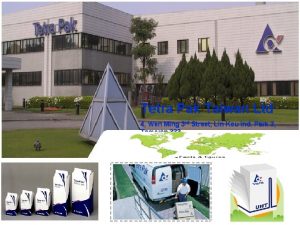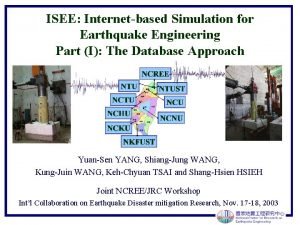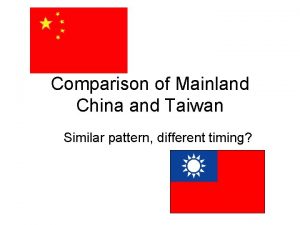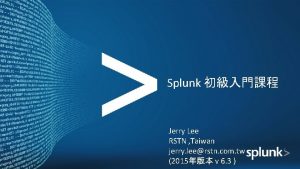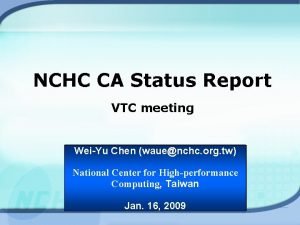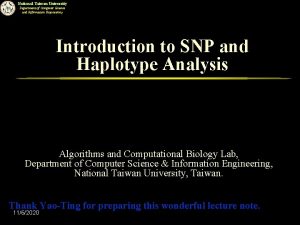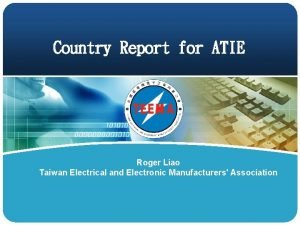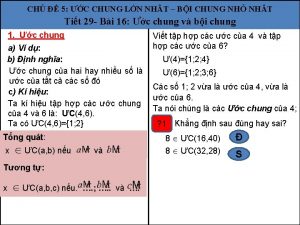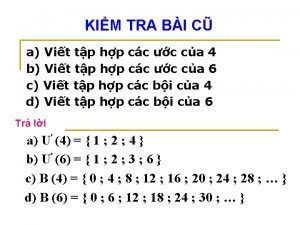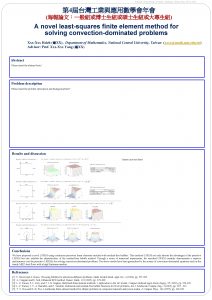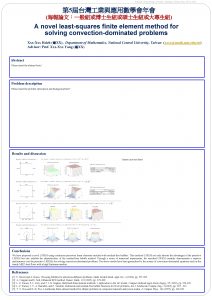Taiwan Uni Grid YehChing Chung Department of Computer

































































- Slides: 65

Taiwan Uni. Grid Yeh-Ching Chung Department of Computer Science National Tsing Hua University Hsin-Chu, 300, Taiwan

Outline • • Introduction Portal Broker and Scheduler Resource Information Service Storage Service Applications Conclusion

Introduction (1) • The purpose of grid computing is to integrate various resources within a large network environment. • The purpose of the Uni. Grid project is to build a platform for academic research using grid-related technologies in Taiwan.


Introduction (3) • All institutes that participate in the Uni. Grid project contribute some resources. • These resources can be used in collaboration for large scale applications.

Introduction (4) • System Architecture

Outline • • Introduction Portal Broker and Scheduler Resource Information Service Storage Service Applications Conclusion

Portal • The Uni. Grid portal provides an interface for Uni. Grid users to use the resources available in the Uni. Grid system. • Functionalities of the portal – System status monitoring – Single sign-on – User workflow management – Project information

System Status Monitoring (1) • Uni. Grid users can examine the status of system resources through the portal. • The portal gathers the current system information from the information service and present these information to the users.

System Status Monitoring (2) • Screenshot of the system status monitoring web page

Single Sign-On (1) • Single sign-on is a mechanism whereby a single authentication can permit a user to access all resources where he has access permission, without the need to enter multiple passwords. – All user account information are kept in a database at the portal site. – When a user requests a service, his verification data is passed to that service. – The request will be granted only if the identity is verified by the verification web service

Single Sign-On (2) • User identity verification through single sign-on service

User Workflow Management (1) • A Uni. Grid user can design and save his own workflows at the Uni. Grid portal. • A user can select any workflow he designed and execute the workflow through the Uni. Grid portal. • A user can also monitor the status of his workflow through the Uni. Grid portal.

User Workflow Management (2) • Structure of a workflow Workflow sequential execution parallel execution

User Workflow Management (3) • The workflows of each user is stored in the portal storage in XML format. • <flow name="testflow" numstages="3"> <stage name="stage 1" numjobs="1"> <job id="0"> <sortkey>1</sortkey> <runtype>mpi</runtype> <workdir>/home/test/</workdir> <filename>mm_mpi</filename> <runrp>true</runrp> <datafile/> <argu>256</argu> <otherurl/> <cpuno>4</cpuno> </job> </stage> … </flow>

User Workflow Management (4) • Screenshot of the workflow editing web page

User Workflow Management (5) • When an user submits a workflow, the portal will pass the selected workflow information to the broker. • Upon receiving an execution request, the resource broker will find the required resource for that workflow and schedule its execution.

User Workflow Management (6)

User Workflow Management (7) • Users can examine the execution status of his workflow through the portal’s workflow monitoring system. • All workflow execution information are stored in a database at the machine with resource broker installed on it. • The portal queries the database and obtain the current status of a particular workflow. • The status information is processed and presented in the form of web pages.

User Workflow Management (8) • Screenshot of the workflow monitoring web page

User Workflow Management (9) • Screenshot of the Uni. Grid workflow management web page

Outline • • Introduction Portal Broker and Scheduler Resource Information Service Storage Service Applications Conclusion

Broker & Scheduler (1) • The broker provides a uniform interface to access available resources in the Uni. Grid system. • The broker uses the resource information service to obtain the current status of the resources in the system. • After these information are gathered, the broker will allocate the resources that meets the requirements of the current job. • The jobs are then passed to the corresponding local schedulers to be executed locally.

Broker & Scheduler (2) • Broker workflow

Broker & Scheduler (3) • Each participating organization has a local scheduler (Condor) installed to schedule the jobs assigned to that organization. • Condor – A scheduler for large collections of distributively owned computing resources – Developed by the researchers at University of Wisconsin – Specialized for compute-intensive jobs – Uses the “Class. Ad” mechanism to match job requirements to machine status and schedule the jobs according to the matching results

Related Research (1) • Tools have been developed to simulate different load sharing and scheduling policies on computing grid analyze their performance • Queuing methods – Independent clusters – Multiple queues • Forwarding to no-need-to-wait site • Forwarding to shortest-queue site • Forwarding to least-load site, load=

Related Research (2) • Queuing methods (cont’d. ) – Single queue • Multi-pool centralized queue • Single-pool centralized queue – One big cluster – Two-level scheduling • Empty queue only • Shortest queue first • Least load first – Two-level local queues • Forwarding to shortest-queue site

Related Research (3) • Scheduling policies – Non-FCFS • Multi-pool centralized queue • Single-pool centralized queue – FCFS • Two-level scheduling • The performance of Non-FCFS is three times better than FCFS

Related Research (4) • Implementation Approaches – Multi-Pool Centralized Queue • Global queue scheduling in the broker, no local queuing system • Global queue scheduling in the broker, making sure available processors through local queuing system – Single-Pool Centralized Queue • Global queue scheduling in the broker, no local queuing system

Related Research (5) – Two-Level Scheduling (Empty-Queue-Only Multi-Pool Grid) • Global queue in the broker, local queues in the local queuing systems

Related Research (6) • Simulation results Load sharing methods Average waiting time(sec. ) Standard deviation Average waiting ratio Standard deviation 2772. 63 10797. 80 21. 46 148. 07 Forwarding to no-need-to-wait site 111. 08 1658. 17 0. 51 8. 76 Forwarding to shortest-queue site 91. 80 1560. 22 0. 41 15. 59 Forwarding to least-load site 86. 28 1477. 90 0. 30 9. 32 127. 64 1487. 69 1. 03 20. 53 Single-pool centralized queue (slowdown ratio: 6) 2184. 36 17251. 00 23. 84 273. 75 Single-pool centralized queue (slowdown ratio: 5) 200. 71 2845. 86 1. 88 37. 81 Single-pool centralized queue (slowdown ratio: 4) 117. 57 1749. 76 0. 90 19. 42 Single-pool centralized queue (slowdown ratio: 2) 61. 71 946. 55 0. 47 13. 88 Single-pool centralized queue (no slowdown) 50. 36 774. 95 0. 37 11. 00 Independent clusters Local queue based methods Centralized queue based methods Multi-pool centralized queue

Related Research (7) • Simulation results (cont’d. ) One big cluster 50. 36 774. 95 0. 37 11. 00 Empty-queue-only multi-pool grid 67. 86 1239. 00 0. 22 6. 34 Shortest-queue-first multipool grid 75. 23 1361. 69 0. 23 5. 14 Least-load-first multi-pool grid 73. 22 1331. 80 0. 28 8. 50 94. 51 1764. 42 0. 34 10. 47 Two-level scheduling Methods with two local queues Forwarding to shortestqueue site

Related Research (8) • Discussion – Non-FCFS methods can effectively improve the overall system utilization and performance. – The smallest first non-FCFS policy outperforms all other policies in terms of waiting time and waiting ratio. – As the worst case is concerned, the backfilling policy is superior because it does not allow jobs to be delayed by the backfilling activities

Outline • • Introduction Portal Broker & Scheduler Resource Information Service Storage Service Applications Conclusion

Resource Information Services • The resource information service provides information about current resource status, these information can be used by other services of the system • Functionalities of the resource information service – Information system – Performance visualization of MPI parallel program’s execution

Information System (1) • Provides an interface for other services to query various information about computing nodes – The statistics about the individual nodes are obtained using MDS (Monitoring & Discovery Service) provided by the Globus Toolkit – The current network status between machines are gathered using NWS (Network Weather Service) • Automatic update of node information – When a new computing nodes is added/removed

Information System (2) • The Network Weather Service (NWS) – A distributed system that periodically monitors and dynamically forecasts the performance various network and computational resources can deliver over a given time interval – Developed by the researchers at UCSB – It uses numerical models to generate forecasts of what the conditions will be for a given time frame – Because this functionality is analogous to weather forecasting, the system is called Network Weather Service

Information System (3)

Information System (4) • Screenshot of the node status webpage

Performance Visualization of MPI Programs (1) • Input: any application (depending on the availability of compiler in grid platform) • Output: performance visualization of the execution of this application

Performance Visualization of MPI Programs (2) • Execution of a Parallel Application using 4 computing nodes

Related Research (1) • Communication localization & data partitioning techniques in cluster-based grid system – Localized communication enhances performance of parallel applications on grid – Adaptive data partitioning for identical cluster & non-identical cluster grid topology – In-core & out-of-core applications

Related Research (2) • Communication localization techniques for identical cluster Original communication patterns Localized communication patterns

Related Research (3) • Communication localization techniques for nonidentical cluster Original communication table

Related Research (4) • Communication localization techniques for nonidentical cluster (cont’d. ) Localized communication table

Outline • • Introduction Portal Broker and Scheduler Resource Information Service Storage Service Applications Conclusion

Storage Service • The goal of storage service is to provide a collaborative space where Uni. Grid users can share their data and resources with others. • Components of the storage service – Virtual storage system – Data management system

Virtual Storage System (1) • Virtual storage system architecture

Virtual Storage System (2) • The virtual storage system is implemented with Java as a web service • Uni. Grid services access the virtual storage system when they need to fetch/modify users’ data files • A client program is available for users to manage his own storage space • The files are stored in a master file server and replicas of the files are distributed to other machines

Virtual Storage System (3)

Virtual Storage System (4) • Screenshot of the storage service client program

Data Management (1) • The Data Management is the Web-based Replica Access and Management System • It consists of the Registration, Search and Manager system – The registration system is used in managing the user for accessing the Uni. Grid System – The search system combines with the RLS and Web technique – The manager system offers a friendly interface for manager, it will be easy to maintain the contents of database • Structure of the Data Management System

Data Management (2) • Replica Location Service

Data Management (3) • The Registration System – In Security • We design a web registration system • User need to be registered in portal and logged in by CA (Proxyinit) – In account manage • Administrator • User • The detailed structure of Web Service System

Data Management (4) • The Search System – Replica Index and Replica Location • In LRC Sever, we can execute the basic command. • We can update information of LRI server use the batch command – Services • We offer the service of the Job submit, files list, files upload and data replication in single server • The detailed structure of Web Service System

Data Management (5) • The Manager System – We plan to design a friendly interface for manager, it will be easy to maintain the contents of Metadatabase, update the RLS database and manage user’s account • The detailed structure of Web Service System

Outline • • Introduction Portal Broker and Scheduler Resource Information Service Storage Service Applications Conclusion

Applications 1 Simulations of atmospheric circulations with the NTU/Purdue nonhydrostatic numerical model. Model characteristics: Nonhydrostatic Explicit forward-backward integration for both high-frequency waves and gravity waves Implicit diffusion scheme with a TKE prognostic equation Time split schemes for high-frequency waves, gravity waves, diffusion, and surface processes. Physical processes: Cloud microphysics Surface similarity equation 3 -layer soil model Coriolis force

Performance with the Uni. Grid 2 Dimension Machine name NCHC-unigrid Ntu-Cluster Physical time 5 hr Running time 12 hr 17 min 12 hr 35 min 3 Dimension Physical time Running time 50 sec 30 min 50 sec 31 min

Commands for submitting jobs host #NTU uninode 11 2 uninode 12 2 uninode 14 2 uninode 15 2 host 1 uninode 11 uninode 10 uninode 12 uninode 14 uninode 15 uninode 7 uninode 9 /opt/mpich/pgi/bin/mpirun –nolocal –machinefile host –np 8 nonh 3 d. exe > test & makefile OBJ = nonh 3 d. o tograds. o copy. o update. o sound. o adv. o cloud 1. o dampini. o initial. o restart. o nbr 2 d. o startend. o tkeeq. o updtrp. o sprogi 4. o sprogi 2. o diffxy. o diffz. o pbl. o EXE =. . /nonh 3 d. exe OPT = -O 3 -Mextend -Msave -Bstatic -byteswapio #OPT = -O 3 -static -ffixed-line-length-80 #OPT = -O 3 -static #OPT = -O 3 #OPT = -static $(EXE) : $(OBJ) /opt/mpich/pgi/bin/mpif 77 $(OPT) -o $(EXE) $(OBJ). f. o : /opt/mpich/pgi/bin/mpif 77 $(OPT) -c $< clean: rm -f *. o. . /nonh 3 d. exe

Three-dimension simulation of a thermal bubble in an isentropic environment Initial spherical bubble develops into a mushroom-like shape. Two isentropic surfaces are shown. The isentropic surface corresponding to a higher potential temperature is in pink.

Two-dimensional simulation of a sea breeze 10 z 5 km 0 0 SBF 15 km x 30 The figure shows the total water mixing ratio (vapor plus liquid) over land after 2. 5 hr. The label under the x-axis is the distance from the coastline. Water vapor is pumped up from the ground surface in the convective boundary layer (with the red/orange color representing high water vapor content in the air). The location of the sea breeze front (SBF) is shown.

Applications 2 • FASTA – Compares a protein sequence to another protein sequence or to a protein database, or a DNA sequence to another DNA sequence or a DNA library

Applications 3 • Clustal. W – A general purpose multiple sequence alignment program for DNA or proteins.

Conclusions and Future Work • A prototype of Uni. Grid system has been developed • Enhance the data grid part of Uni. Grid • Promote the Uni. Grid system to universities in Taiwan
 Chúng tôi đứng trên núi chung
Chúng tôi đứng trên núi chung Lga pga
Lga pga Celofobia
Celofobia Open science grid computer
Open science grid computer Taiwan earthquake
Taiwan earthquake Ptt tw drama
Ptt tw drama Tetra pak taiwan
Tetra pak taiwan Hello my name is sussi
Hello my name is sussi Taiwan earthquake
Taiwan earthquake Taiwan earthquake
Taiwan earthquake Providence university taiwan ranking
Providence university taiwan ranking Taiwan earthquake
Taiwan earthquake Taiwan size comparison
Taiwan size comparison Inflation means taking on
Inflation means taking on Taiwan earthquake
Taiwan earthquake Taiwan id card
Taiwan id card National science council taiwan
National science council taiwan Taiwan's gift to the world
Taiwan's gift to the world Taiwan logistics industry
Taiwan logistics industry Gartner group taiwan
Gartner group taiwan Taiwan gnp
Taiwan gnp Tipa taiwan
Tipa taiwan Taiwan earthquake
Taiwan earthquake Lf logistics taiwan
Lf logistics taiwan Taiwan earthquake
Taiwan earthquake Ppp9 taiwan
Ppp9 taiwan Christophe fond
Christophe fond Manager or supervisor higher
Manager or supervisor higher Taiwan physical geography
Taiwan physical geography Taiwan earthquake
Taiwan earthquake Taiwanese mandarin
Taiwanese mandarin Taiwan earthquake
Taiwan earthquake Wow prime taiwan
Wow prime taiwan Educational system in taiwan
Educational system in taiwan Ftse4good tip taiwan esg index
Ftse4good tip taiwan esg index Taiwan glass group
Taiwan glass group Splunk timechart useother
Splunk timechart useother Taiwan earthquake
Taiwan earthquake Taiwan fcm
Taiwan fcm Taiwan mom
Taiwan mom Wei yu taiwan host
Wei yu taiwan host Taiwan myanmar 2d
Taiwan myanmar 2d Fmcg taiwan
Fmcg taiwan Taiwan energy efficiency label
Taiwan energy efficiency label Introduce taiwan to foreigners
Introduce taiwan to foreigners Sally ts menu
Sally ts menu Taiwan's gift to the world
Taiwan's gift to the world Located
Located Taifex
Taifex Triangular shaped population pyramid
Triangular shaped population pyramid Taiwan earthquake
Taiwan earthquake Taiwan
Taiwan Taiwan
Taiwan Ich komme aus taiwan
Ich komme aus taiwan Ptt
Ptt Mascot taiwan
Mascot taiwan Eximbank taiwan
Eximbank taiwan Capital of taiwan
Capital of taiwan Taiwan earthquake
Taiwan earthquake Fornatie
Fornatie Ubuntu taiwan mirror
Ubuntu taiwan mirror Lyrics inverter taiwan
Lyrics inverter taiwan Colonialism and development: korea, taiwan, and kwantung
Colonialism and development: korea, taiwan, and kwantung Taiwan earthquake
Taiwan earthquake Peta china taiwan hongkong dan macau
Peta china taiwan hongkong dan macau Taiwan earthquake
Taiwan earthquake






